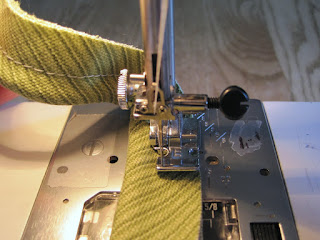Nothing gives a crisper finish to a cushion than a neatly piped edge. You can of course buy piping ready-made - but why buy it when you can make it? (And if you're going to make it, why not make it from scratch, cording and all?)
Here's my recipe:
Homemade Piping
Yarn (I used worsted weight kitchen cotton)
Scrap thread or yarn, about 3"
Hand mixer
Fabric
Scissors
Thread
Sewing machine
Rotary cutter and mat (optional but helpful)
Ruler
~ ~ ~
Determine how long your piping needs to be. Cut a piece of yarn 6 times as long as the finished length, plus 6" to allow for the knotted ends. (I needed about 60" of piping, so I cut 360" + 6" of yarn.)
Loop the yarn through one beater.
Tie the two ends in a loose knot.
Holding the knot, walk away from the mixer until the beater is at the halfway point of the yarn.
Bring the knot back to the mixer. Holding the knot and the looped end together, run your other hand between the two double strands until you reach the halfway point. Tie your scrap yarn or thread around this spot.
Put your finger through the knotted end of the yarn. Turn the mixer on low, and back away across the room until your yarn is gently suspended as it is twisted by the mixer. (I'm sorry I couldn't take a picture of myself at this point. You'll just have to imagine it.)
Keep an eye on the twisting yarn. When it's roughly twice your desired finished length, stop the mixer. As you walk back towards the mixer, hook a finger through the yarn at the halfway point - the spot with the scrap tied around it. This is where you want the yarn to fold back on itself.
Snip the yarn loose from the beater and tie the four ends together. At this point it will be twisting wildly around itself, probably unevenly. That's okay.
Your knot should be at one end of your cord, and the scrap yarn marker at the other. If your yarn is all kinked up and uneven, gently separate the twisted double strands where necessary and then let them re-twist. (I had to do this in several places.)
And here's your homemade cording...
...ready to be covered with the fabric of your choice.
Cut enough bias strips of fabric to equal your desired length. Don't forget to allow a bit extra for seams. I cut my strips 2" wide. (If you don't have a rotary cutter, grid ruler, and mat, or would like more detail than I've provided, see this excellent tutorial for tips on how to mark and cut bias strips.)
Sew the ends of your bias strips together. I used a short stitch length and a 1/4" seam. No need to backstitch at the beginning or end of each seam - just line up the pieces and sew one long seam, moving from one set to the next.
Clip between the pieces to separate them, then clip off the little corners that are sticking out at the end of each seam.
Press the seams open, and lay your cording down the middle.
Fold the bias strip over the cording...
...and use a zipper foot to baste the piping closed. (It's okay if it's a bit loose at this point. You can sew closer to the cording later, when you attach the piping to your project.)
And here's my finished piping. I've got just enough to go around a cushion...
...but that's a subject for another post.
~ ~ ~ ~ ~ ~ ~ ~ ~ ~ ~ ~














Wow, does that piping look professional! I never knew one could make homemade cording.
ReplyDeletewhat a great idea! Mich x
ReplyDeleteWhat a great idea!! I would never have thought of doing that from scratch. I always have some yarn bits around, so instead of going out to buy some cording, next time I will make it. Thanks for the great tutorial.
ReplyDeleteI make my own piping all the time, but I have never considered making my own cording. Wow! This is certainly the most creative use of a mixer I have ever seen:)
ReplyDeleteA rather tardy thanks to all of you!
ReplyDeleteWhat a great idea!! Thank you so much! I cant wait to try the Mixer!!
ReplyDeleteProfessional repipe work with long-lasting results. Repipe in houston
ReplyDelete